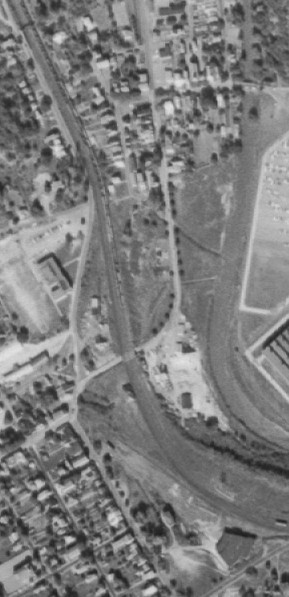Just south of this tower is a building that displays a preserved line-shaf driven machine shop.
 |
| Street View, Jul 2019 |
.jpg) |
| HABS IOWA,31-DUBU,1--5 (CT) |
 |
| Akash Tripura posted The Shot Tower - Lead for ammunition during the Civil War was melted at the base of the tower, hoisted to the top, poured through screens of different gauges, tumbling smoothly round as it fell into the water vats below. The shot was then sorted and packed. When completed, the tower could produce between 6 to 8 tons daily, but it was rarely operated at full capacity due to being bought by competitor Chadburne and Forster in 1862. From 1872 - 1881 a statue of Andrew Jackson on horseback stood on top of the tower. In 1877, a permanent interior spiral staircase was constructed. In 1881, a framed glass observatory was added to the top to convert it into a fire watchtower for Standard Lumber Company, which occupied seven blocks around the structure. After a fire in 1911 the building was. It stood roofless until a concrete cap with a hatchway was added in 1960 and replacement brick was used to reconstruct the lost upper portion of the top floor. Mark Higley: Akash: incorrect that lead was melted at the base and hoisted. Other way around: For the shot-making process, lead was melted at the top of the Dubuque Shot Tower. It was then poured through a sieve, allowing droplets to fall down the inside of the tower. The process worked as follows: Melting at the top: A furnace at the top of the tower heated the lead until it was molten. Sieving and dropping: The molten lead was poured through a grate or sieve. As the droplets fell, gravity and surface tension naturally pulled them into nearly perfect spherical shapes. Cooling at the bottom: The partially cooled droplets fell into a basin of water at the bottom of the tower, which solidified them and preserved their round shape. The height of the tower was crucial to the process, allowing enough time for the lead droplets to form perfect spheres before reaching the water. Ray Newell: At the beginning of the Civil War there might have been a need for round bullets for older weapons that were called into use. The rifled arms you see in Civil War museums were the main weapons in use, and used conical bullets not balls. Shot towers pretty much went out of use in the late 1850's, when the army was moving from smoothbores to rifles. Mark Perina Ray Newell: Shot for shotguns not round balls for rifles. Ray Newell: Mark Perina Makes much more sense. |
This video says it all.
 |
| BeHistoric posted This video investigates the Dubuque Shot Tower, also known as the George W Rogers Shot Tower, located within a stone's throw of the Mississippi River, in Dubuque, Iowa. The tower's origins, early history, role in the Civil War, changing ownership, multiple fires, neglect and decay, and recent restorations are all explored. https://youtu.be/yz9-4Prc4z0?si=XPQXjjbIgab4c0m1 |
 |
| Tod Riebow shared via Dennis DeBruler [The person who colorized this postcard throught the shot tower on the other side of the river was a smokestack.] |



.jpg)










.jpg)


























.png)

.jpg)
